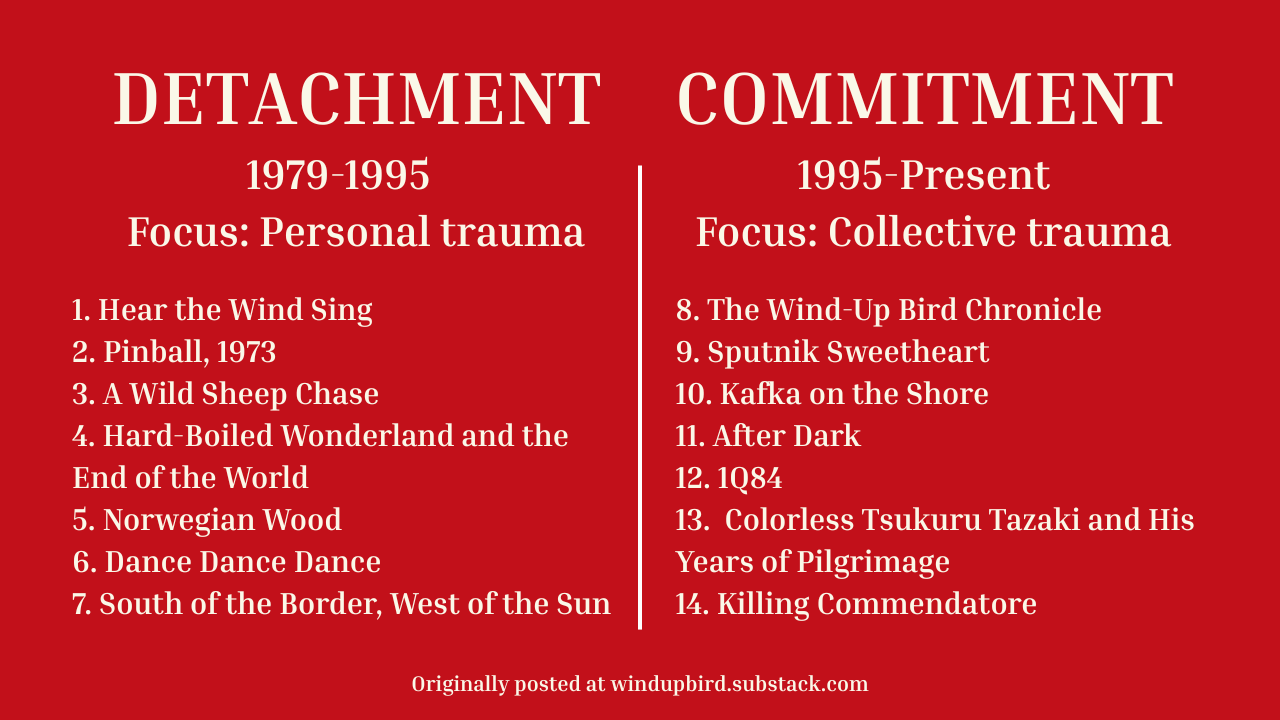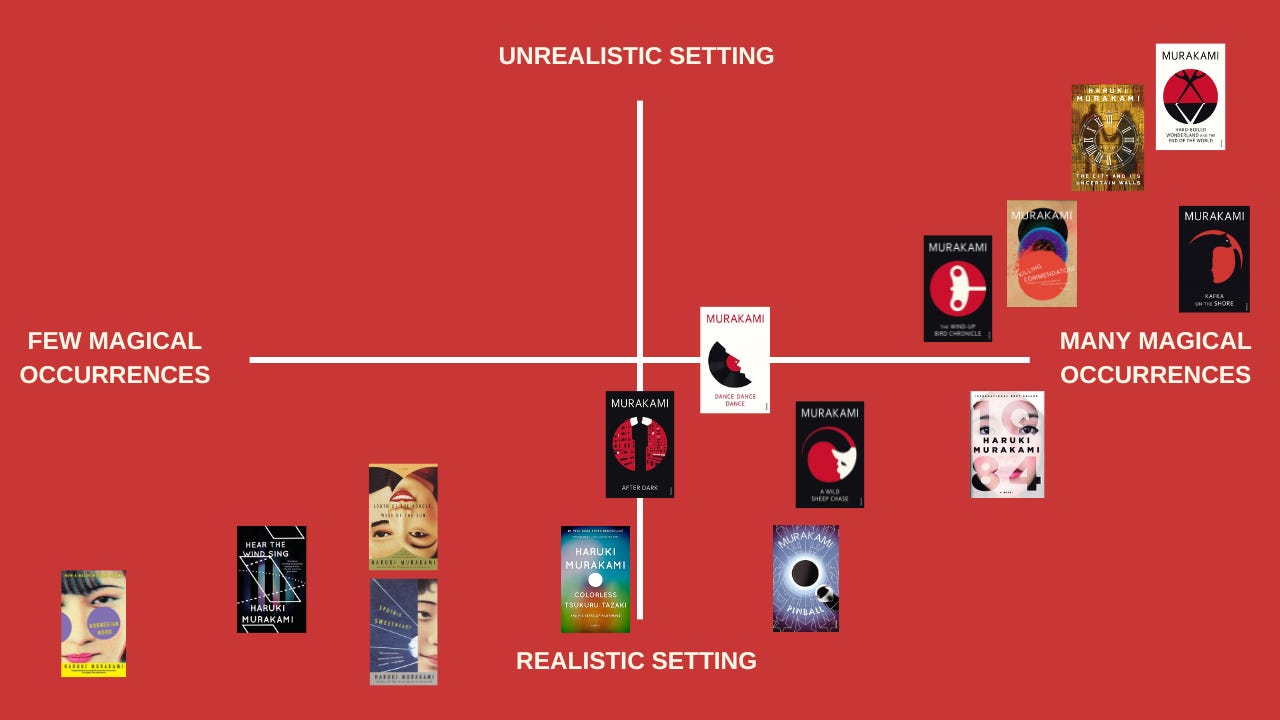In my book, Murakamian Magical Realism and Psychological Trauma, I included a black-and-white scatter plot graph to show how the author varied two types of realism in his fiction. It aimed to show how realistic his depictions of places were versus his depictions of occurrences. Due to the constraints of printing books, it didn’t look very sophisticated:
Today, I finally got around to making a nice colourful version, which you can see here:
These are merely my interpretations of his books and I don’t intend them to be viewed as a definitive guide. I’m sure many of you will disagree with my labelling of certain texts, so feel free to make your criticisms in the comment section. However, I will give a very, very brief sort of defence/explanation of my chart below.
Hear the Wind Sing
I believe this book is quirky more than supernatural. It is set in a realistic version of modern-day Japan and the events are improbable but not impossible.
Pinball, 1973
This novel again takes place in a realistic version of Japan but is a bit more “out there” than the first book. The events move beyond the improbable and towards the impossible and there is a scene that appears to include the unnamed protagonist crossing over into another world and communing with a dead girl in the form of a pinball machine.
A Wild Sheep Chase
This book features a lot of realistic modern Japan; however, when it moves from urban to rural, we feel that the protagonist is again in another realm. He then speaks with his dead friend, who has taken the form of a tiny man dressed like a sheep.
Hard-Boiled Wonderland and the End of the World
This was Murakami’s first wildly unrealistic novel. It is set in the future, where some kind of monsters exist, and also in a fantasy land. The events and occurrences are both extremely unreal. (Note: This book was recently re-released with a new translation.)
Norwegian Wood
This is widely considered Murakami’s most realistic novel and he has referred to it as a deliberate departure from his previous works. He wanted to try realism in order to test himself as a writer. However, I would contend that the magical lies just below the surface and is hinted at if not explicitly shown.
Dance Dance Dance
This book is intended as a critique (an unsubtle one) of modern-day capitalism and it depicts very real parts of modern Japan. However, occasionally it ventures into fantasy when the protagonist accidentally crosses the threshold into another realm.
South of the Border, West of the Sun
This novel is largely realistic but with slight ventures into the unreal. This is a quite typical Murakami approach but here he is a bit more subtle than in other books. The unreal parts have a dream-like quality.
The Wind-Up Bird Chronicle
This is my favourite of his books by far. It captures everything he had tried to achieve as a writer until this point. It shows him boldly depicting unreal people, places, and events, but also mixing them with tragic and sometimes brutal realism. This is partly what made him so famous for his magical realist style.

Sputnik Sweetheart
Like Norwegian Wood, this book is mostly lacking in unreal people, places, and characters. However, if you look hard enough you will find them. Are they hallucinated? Murakami is vague here and it’s for the reader to decide.
Kafka on the Shore
In terms of absurd characters and impossible action, this book is off the scale. We have a man who can talk to cats, magical beings that take the form of corporate mascots, fish falling from the sky, and much, much more. However, the book largely takes place in the real world with only a late departure into other realm we have so often seen in other books.
After Dark
Murakami’s most underrated book is set in a hyper-real Tokyo but also another realm. Even in the real-world Tokyo we have glimpses of the other world. In Murakami’s fiction, there often isn’t much separating the two, and never is that clearer than in After Dark.
1Q84
This massive novel is set in a believable Tokyo but has many departures into fantasy with bizarre creatures appearing. Also… is it really Tokyo or is this another world that is just a little different from our own?
Colorless Tsukuru Tazaki and His Years of Pilgrimage
The settings of this novel seem very real to me and there are certainly fewer magical occurrences than in other books. However, they do occur and there is always a sense that things are not quite as they seem.
Killing Commendatore
This was the last book mentioned in my study of Murakami’s work because his latest came out after it was released. This largely takes place in a realistic setting but then towards the end enter a fantasy world. The hints at the supernatural eventually turn into a full-blown magical escapade.
The City and Its Uncertain Walls
This book includes much of Hard-Boiled Wonderland and the End of the World, from which it was adapted. At least, it includes the fantasy element, but not the sci-fi one. There are other parts added to the story that are more realistic but even here there is always an element of the unknown and uncertain. (Here’s my review.)






I enjoyed this analysis and visualization! I wanted to see where my interest lies with his work, but I cannot even decide! But I tend to lean more towards magical realism, the setting does not matter much.
When I try to recall his settings, I realize I can only remember a few details, but more of how I felt. Maybe that's his skill—even his realistic settings felt dreamlike.
I’m very interested to read your book on Murakami! He’s one of my favourite writers (1Q84 being one of my favourite novels ever written!).
I actually read your book Scientologist! last year while I was writing an essay on William S. Burroughs for a module at University. It was brilliant, and the first time I really understood Korzybski’s influence on Burroughs!
So thank you for that! I’ll try and pick up your book on Murakami soon. all best wishes!